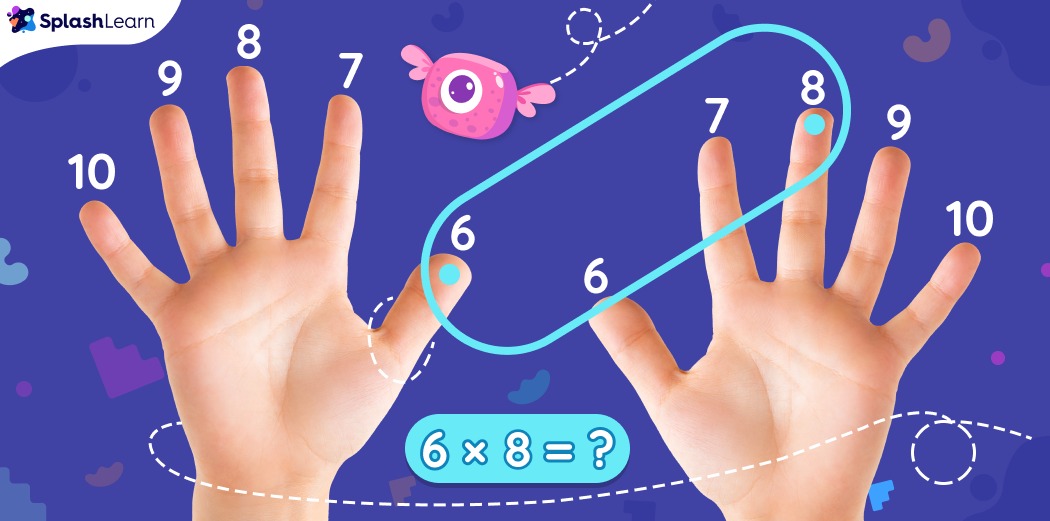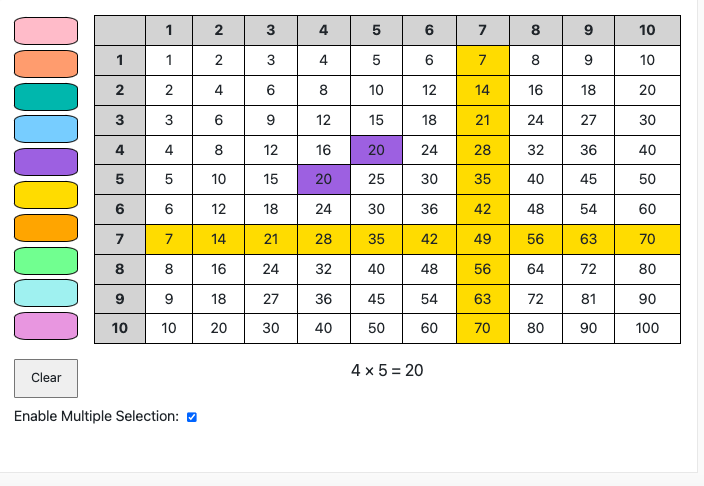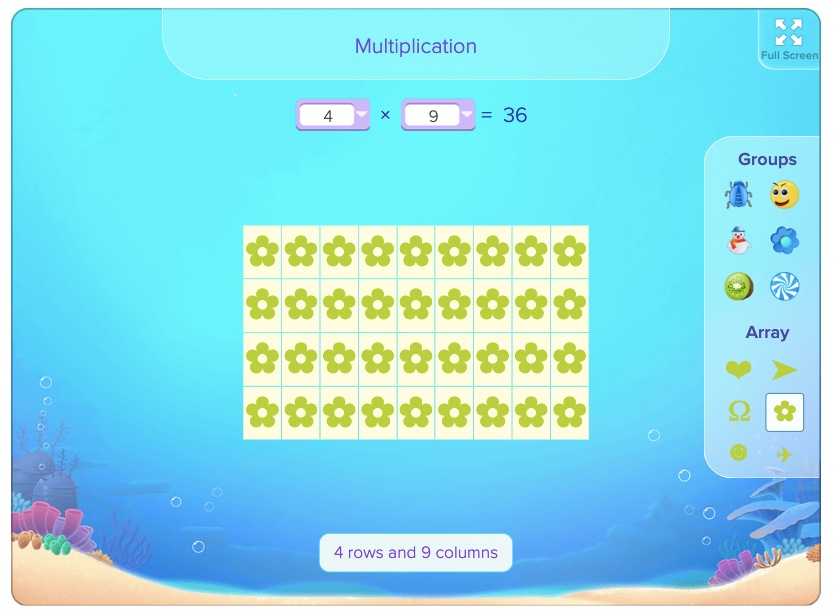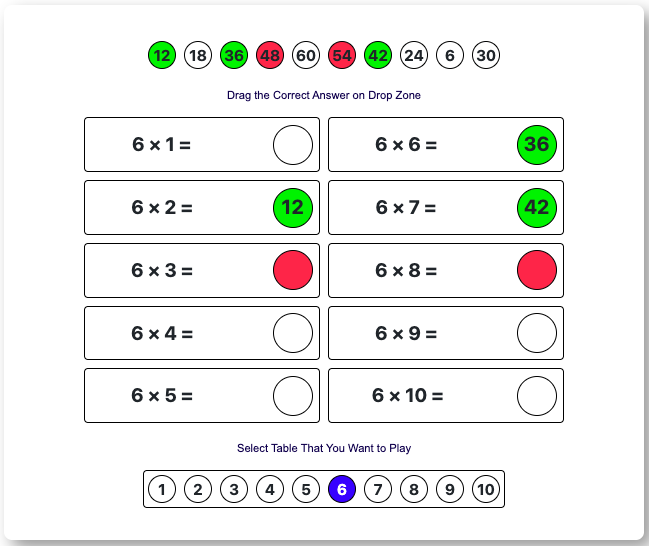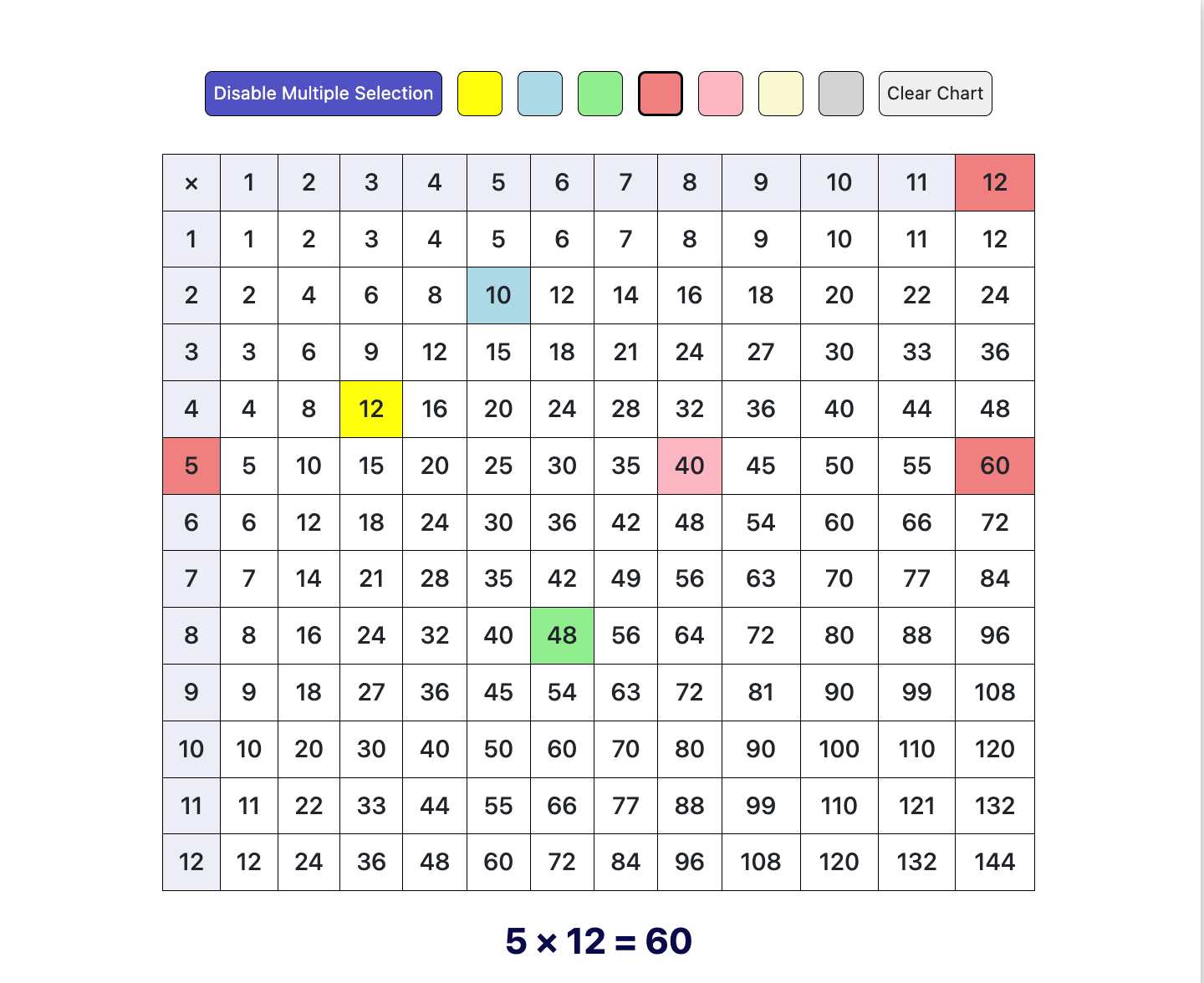What’s 7 times 8?” A long pause. A guess. A wrong answer.
Many parents know this struggle. Flashcards, drills, frustration—learning times tables can feel like a battle. How to teach time tables in a way that actually works is a common question. Some children memorize them quickly, while others struggle no matter how much they practice.
Math & ELA | PreK To Grade 5
Kids see fun.
You see real learning outcomes.
Watch your kids fall in love with math & reading through our scientifically designed curriculum.
Parents, try for free Teachers, use for free
Memorizing times tables is important because it makes all future math easier. When children know them well, they can solve bigger problems faster and with confidence. But forcing memorization alone isn’t always the answer. Some methods work better than others, and knowing what helps and what hurts can make all the difference.
With the right approach, children can learn multiplication faster and with less stress. The trick is to use strategies that make sense to them.
This blog will share easy, effective ways to teach times tables. These have helped thousands of children in the classroom, and they can help at home too.
7 Biggest Mistakes You Are Making While Teaching Times Tables
Before getting into how to teach times tables, it’s important to check if any common mistakes are slowing down progress. Many of you make these errors without realizing it. Recognizing them early helps in adjusting the approach for better results.
1. Focusing only on rote memorization
Simply making a child repeat multiplication facts over and over doesn’t always work. Some children memorize quickly, but others struggle to recall facts when needed. Understanding patterns and connections makes learning easier and more effective.
2. Moving too fast
Multiplication builds on earlier math skills like addition and skip counting. If a child hasn’t mastered these, jumping straight into memorization can cause frustration. Start with skip counting and patterns before expecting full recall.
3. Not teaching the meaning of multiplication
If a child doesn’t understand what multiplication represents, they are just memorizing numbers with no real connection. Show them that multiplication is repeated addition and use real-life examples like grouping objects or arrays to help them visualize it.
4. Teaching in order from 1 to 12
Starting with 1×, 2×, 3×, and so on isn’t the best way. Some numbers are easier than others. It’s better to begin with 2s, 5s, and 10s, which have simple patterns, then move on to trickier numbers like 7s and 8s.
5. Ignoring the commutative property
Many children don’t realize that 4×6 is the same as 6×4. Teaching this cuts the number of facts they need to learn in half. Reinforce this concept early to reduce the workload.
6. Relying only on flashcards and drills
Flashcards are helpful but shouldn’t be the only method. Some children learn better with games, songs, visual aids, or hands-on activities. A mix of strategies works best.
7. Not practicing regularly
Cramming multiplication facts all at once doesn’t work. A little practice every day is much more effective than long, tiring sessions. Just 5-10 minutes a day can make a big difference.
Using the Right Language When Teaching Times Tables
Before teaching times tables, ensuring that you are using a consistent approach can make learning much easier. One important thing is how to say multiplication facts.
There are different ways to say them, and all are correct. However, being consistent helps children understand faster. It’s even better if you use the same language their child hears at school.
Here are some common ways to say multiplication facts:
- “Three times four is twelve.” (Most common)
- “Three groups of four make twelve.” (Great for visual learners)
- “Three multiplied by four equals twelve.” (Formal but correct)
- “Three lots of four are twelve.” (Used in some schools)
6 Easy Steps to Teach Times Tables
Before jumping into memorization, it’s important to focus on how to learn times tables in a way that actually makes sense. Here is a step-by-step guide for you:
1. Build the Basics First
Now that you know what not to do and the tricks that actually work, let’s get into what to do- the best way to learn times tables fast using a structured approach.
Like any other math concept, the first step is to check the basics. Multiplication requires a strong foundation in addition, number patterns, and grouping. If these are not clear, jumping into memorization will only lead to frustration.
I. Strengthen addition and skip counting
Multiplication is really just repeated addition. A child who struggles with basic addition will have trouble with times tables. Before teaching multiplication, check if they can:
- Quickly add small numbers (e.g., 3 + 3 + 3 = 9).
- Skip count by 2s, 5s, and 10s (since these patterns make multiplication easier).
II. Introduce multiplication as “groups of”
Many children struggle with times tables because they see them as random numbers to memorize rather than a simple way to count groups.
Explain it like this:
- 2 × 3 means “2 groups of 3.”
- 4 × 5 means “4 groups of 5.”
III. Use arrays for a visual approach
Some children learn best when they can see how numbers work. Arrays (rows and columns of dots or objects) help make multiplication more concrete.
Example: To show 3 × 5, draw:
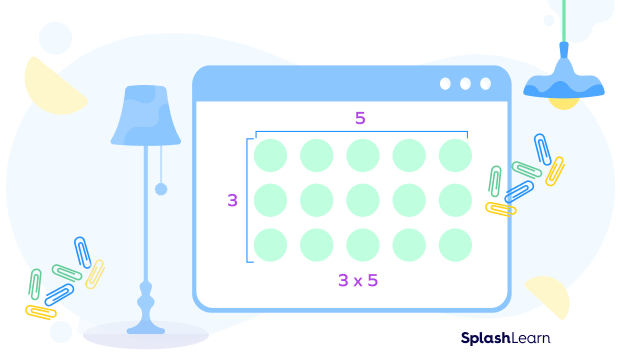
This is three rows of five. Ask them to count all the dots and see how multiplication helps them get the total faster.
IV. Relate multiplication to addition
Children often mix up addition and multiplication. Show them how multiplication is just a shortcut for adding the same number multiple times.
Example:
- Instead of adding 5 + 5 + 5, we can simply say 3 × 5 = 15.
If you find your child struggling with skip counting or adding, have them practice these games first. Here your child will count by 2s, 5s, and 10s on a hundreds chart, count objects in pairs, understanding the rows and columns in an array and more to tackle fun challenges.
2. Start with the Easy Patterns
Now that the basics are clear, it’s time to teach kids times tables in a way that builds confidence before moving on to harder numbers- start teaching multiplication facts. But instead of going in order from 1 to 12, begin with the easiest patterns.
Some times tables follow simple rules, making them easier to remember. Teaching these first helps children gain confidence before moving on to trickier numbers.
I. The ×2 Times Table – Think of It as Doubling
The ×2 table is one of the easiest because it’s just doubling a number. If a child knows how to add the same number twice, they already understand the concept.
- 2 × 3 = 6 (same as 3 + 3)
- 2 × 7 = 14 (same as 7 + 7)
❖ Try this: Instead of saying, “What is 2 × 6?”, ask “What is 6 doubled?” This helps children connect multiplication with something they already know. Let them use their fingers—hold up a number of fingers and ask them to double it.
II. The ×10 Times Table – Just Add a Zero
The ×10 table is the simplest pattern of all. Any number multiplied by 10 just gets a zero added to the end.
- 3 × 10 = 30
- 6 × 10 = 60
- 9 × 10 = 90
❖ Try this: Say a number and have your child snap their fingers while adding a zero (e.g., “4 times 10?”—Snap!—”40!”).
III. The ×5 Times Table – Watch for the Pattern
The ×5 table follows a predictable pattern—every answer ends in 0 or 5.
- 1 × 5 = 5
- 2 × 5 = 10
- 3 × 5 = 15
- 4 × 5 = 20
❖ Try this: Teach them to use their hands—count by 5s on their fingers (each finger represents 5).
Have your kids play these multiplication pattern games. These games help children see patterns and practice over and over without getting bored. Through drag-and-drop challenges, they’ll gain confidence in multiplication and division, exploring facts:
Begin here
3. Move to the Mid-Level Tables
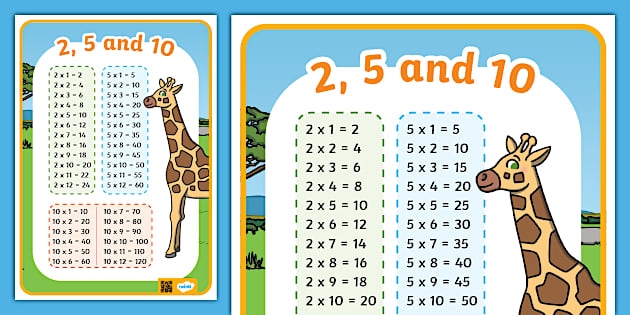
Now that your child has mastered the easy patterns (2s, 5s, and 10s), it’s time to move to the mid-level tables. These are slightly harder but can still be learned with simple tricks.
At this stage, patterns and connections become even more important. Instead of memorizing each fact separately, children can use what they already know to learn new facts faster and with less effort.
1. The ×3 Times Table – Use Skip Counting
The ×3 table follows a clear skip-counting pattern: 3, 6, 9, 12, 15, 18…
- Try this: Have your child say the numbers in a rhythm:
“Three, six, nine… let’s keep in time!” - Fun trick: Hold up three fingers and skip count by 3s while pointing at each finger.
- Pattern to remember:
The digits repeat in a cycle (3, 6, 9, 2, 5, 8, 1, 4, 7, 0).
Every answer in the 3 times table adds up to a multiple of 3 (e.g., 3 × 7 = 21 → 2 + 1 = 3).
2. The ×4 Times Table – Double the ×2 Facts
The ×4 table is just doubling the ×2 facts. If a child already knows their 2s, they can use that to quickly find the 4s.
- Example:
4 × 3 = 12 is the same as 2 × 3 = 6, then double it (6 + 6 = 12).
4 × 7 = 28 → Think: 2 × 7 = 14, then double it (14 + 14 = 28).
❖ Try this: Instead of memorizing, first ask “What is 2 × 6?” then say “Now just double it!”
3. The ×6 Times Table – Build from ×3 Facts
The ×6 table is easier when you think of it as double the ×3 facts (since 6 = 3 × 2).
❖ Example:
6 × 4 = 24 → Think: 3 × 4 = 12, then double it (12 + 12 = 24).
6 × 7 = 42 → Think: 3 × 7 = 21, then double it (21 + 21 = 42).
❖ Try this: If a child knows 3 × a number, they can double that to find 6 × the same number.
❖ Pattern to remember:
The last digit in the answers always follows the 6, 2, 8, 4, 0 pattern.
Every answer in the 6 times table is even.
For extra practice, interactive online multiplication games can reinforce the 3s, 4s, and 6s in a fun and engaging way. Check out these recommended games to help your child practice with ease:
Begin here
4. Introduce the Tricky Numbers with Tricks
Some multiplication facts are harder to memorize, but using the right tricks for learning times tables can make even 7s, 8s, and 9s much easier to remember.
1. The ×9 Times Table – Use the Finger Trick & Number Patterns
The ×9 table seems hard, but it actually has one of the best tricks!
- Finger Trick for 9s
- Hold up both hands with fingers spread out.
- To find 9 × 3, fold down the third finger.
- The fingers to the left are 2 (tens), and the fingers to the right are 7 (ones), so 9 × 3 = 27!
- This works for all the numbers up to 9 × 9.
- Number Pattern for 9s
- The tens place goes up (0, 1, 2, 3, 4…)
- The ones place goes down (9, 8, 7, 6, 5…)
Example:
- 9 × 1 = 09
- 9 × 2 = 18
- 9 × 3 = 27
- 9 × 4 = 36
2. The ×7 Times Table – Use Fun Mnemonics
The ×7 table is one of the hardest because it doesn’t have easy patterns like 5s or 10s. But memory tricks can help!
- Use Funny Rhymes & Stories
- 7 × 7 = 49 → “Seven times seven is like a football team, 49ers!”
- 7 × 8 = 56 → “5, 6, 7, 8” (The answer starts with 5 and 6, the problem starts with 7 and 8).
- Look for Connections
- If your child knows their 6s, remind them that 7 × 6 = 42 is just one more group of 6 added to 6 × 6 = 36.
3. The ×8 Times Table – Use the Doubling Trick
The ×8 table is tricky, but it’s just double the ×4 table (which is already double the ×2 table).
Example:
- 8 × 3 → Think: 4 × 3 = 12, then double it (12 + 12 = 24)
- 8 × 6 → Think: 4 × 6 = 24, then double it (24 + 24 = 48)
- Use the 8, 6, 4, 2, 0 Pattern
- The last digits always follow 8, 6, 4, 2, 0 (e.g., 8, 16, 24, 32, 40…)
- Spotting this pattern makes it easier to recall.
For tricky tables like 7s, 8s, and 9s, online practice can be a great support. Here are some useful games that reinforce these facts through repetition and patterns:
Begin here
5. Teach the Last Few (They’re Easier Than They Seem!)
Now that the tricky numbers are covered, it’s time to teach time tables easily by focusing on the simplest patterns that require minimal effort to remember. They follow simple rules, so children can pick them up quickly with minimal effort.
1. The ×1 Times Table – Always the Same Number
This is the simplest of all. Any number multiplied by 1 stays the same.
- 1 × 3 = 3
- 1 × 7 = 7
- 1 × 12 = 12
How to Explain It: Tell your child, “Multiplying by 1 doesn’t change anything. It’s like having just one of something.”
2. The ×0 Times Table – Always Zero
Another super easy rule: Any number multiplied by zero is always zero.
- 0 × 4 = 0
- 0 × 9 = 0
- 0 × 12 = 0
❖ How to Explain It: Say, “If you have zero groups of something, how many do you have? None!”
3. The ×11 Times Table – The Copycat Rule
Up to 9 × 11, this table is super easy! The trick? Just repeat the number.
- 2 × 11 = 22
- 5 × 11 = 55
- 9 × 11 = 99
- How to Explain It: Tell them, “For numbers 1 to 9, just copy the number twice.”
- What About 11 × 10 and Beyond?
Once they reach 11 × 10 and higher, they need a new trick:
- 11 × 10 = 110
- 11 × 12 = 132 (Think: 11 × 10 = 110, then add 11 × 2 = 22 → 110 + 22 = 132).
4. The ×12 Times Table – Use What They Already Know
The ×12 table might seem difficult, but it can be broken down into easier steps.
- Use the 10s and 2s Trick
- 12 × 4 → Think of it as (10 × 4) + (2 × 4)
- 10 × 4 = 40, 2 × 4 = 8, so 40 + 8 = 48
- 12 × 7 → Think (10 × 7) + (2 × 7)
- 10 × 7 = 70, 2 × 7 = 14, so 70 + 14 = 84
6. Practice Is Key
Practice is the key to mastering times tables. A child may understand multiplication, but without regular practice, they will struggle to recall facts quickly. However, practice doesn’t mean drilling facts endlessly—it needs to be structured, engaging, and effective.
Here are Interactive teaching tools that make practice more meaningful:
Begin here
- Multiplication charts: Click on a number, and the fact appears instantly, helping kids spot patterns.
- Array generators: Type a multiplication fact, and the tool creates equal groups or arrays, making the concept visual.
- Drag-and-drop games: Kids match multiplication facts with answers, receiving instant feedback to identify tricky areas.
- Multiplication chart 1 to 12: Click any box to reveal related facts, highlight multiple numbers to explore commutativity, identity, and zero, and build understanding beyond memorization.
These tools provide hands-on learning, instant correction, and pattern recognition, making practice more than just memorization—it becomes meaningful learning. The key is to make practice daily, engaging, and low-pressure for the best results.
Related Reading: Best Multiplication Tricks for Math Students
Should Kids Memorize Times Tables or Not?
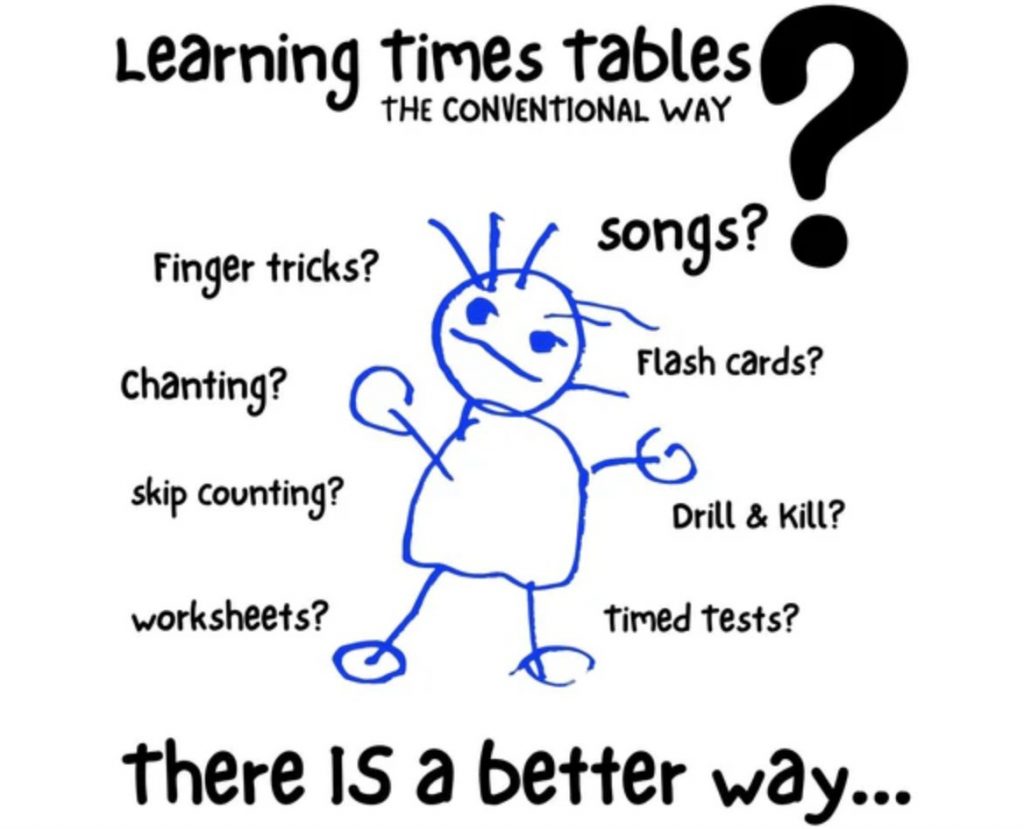
Some teachers swear by memorization, others believe understanding comes first. The truth? Both matter.
Memorization builds speed and confidence and also prepares kids for advanced math. But rote learning without understanding leads to frustration. A child might recall facts but struggle to apply them.
The best approach? A balance. Kids should see the patterns, understand multiplication, and memorize facts naturally through practice. This way, they don’t just know the answers—they understand the numbers behind them.
Now, let’s look at the best ways to help kids memorize their tables—without pressure!
- Singing Times Tables: Set multiplication facts to familiar tunes or rhymes. This musical approach can make recall easier and more enjoyable.
- Display Charts: Place colorful multiplication charts in areas where your child spends time. Regular exposure reinforces learning.
- Flashcards: Use flashcards for quick, repetitive practice. They can be shuffled to ensure facts are learned out of order, promoting true mastery.
- Identify Patterns: Help your child discover patterns in the times tables. For example, the commutative property shows that 3 × 4 is the same as 4 × 3, effectively halving the number of facts to memorize.
- Using Games: Repetition is key, but it doesn’t have to be boring. If you’re wondering how to practice times tables effectively, using times table games, quick recall challenges, and daily short practice sessions can make learning both engaging and efficient.
Mastering times tables takes understanding, practice, and consistency. These tried-and-tested methods show how to teach multiplication tables in a way that builds both recall and understanding. With the right approach, kids don’t just memorize multiplication tables—they apply them with confidence in everyday math.
Related Reading: Easy Tips & Tricks to Learn the 13 Time Table for Kids
Frequently Asked Questions (FAQs)
What is the best trick to remember tables?
The best trick is to use patterns, skip counting, and visualization. For example, doubling for 2s and 4s, the finger trick for 9s, and rhymes for 7s make memorization easier.
How many times tables should your child learn?
Most children learn tables up to 12×12, as they are commonly used in school and real life. However, knowing up to 10×10 is usually enough for everyday math.
Which times table is the easiest and hardest to learn?
The easiest are 2s, 5s, and 10s because they follow simple patterns. The hardest are 7s, 8s, and 9s, as they lack easy patterns and require more practice.
What is the best order to teach times tables?
Start with 2s, 5s, and 10s (easy patterns), then move to 3s, 4s, and 6s. Teach 7s, 8s, and 9s last, using tricks to simplify them. Finally, cover 1s, 0s, 11s, and 12s as they follow simple rules.


